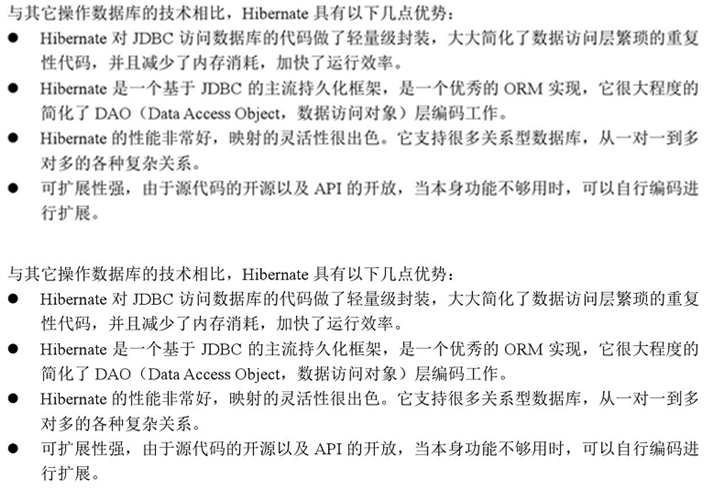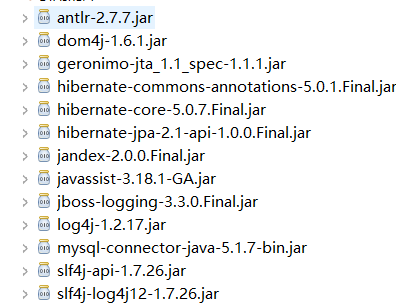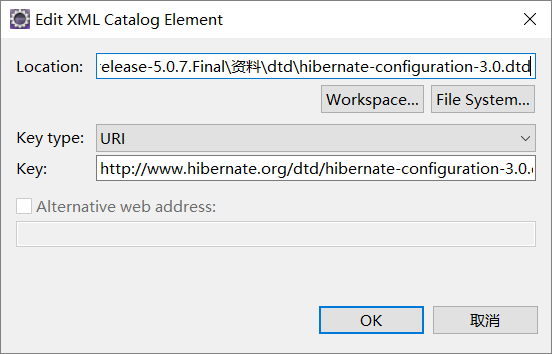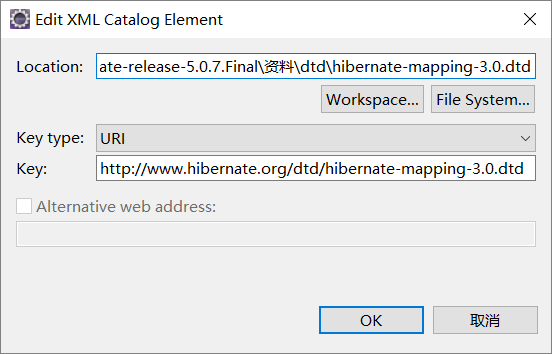Hibernate学习笔记1(常见配置)
1.为什么要学习Hibernate

2.什么是Hibernate

注:ORM:Object Relational Mapping(对象关系映射)。指的是将一个Java中的对象与关系型数据库中的表建立一种映射关系,从而操作对象就可以操作数据库中的表。
3.配置安装
首先下载,解压https://sourceforge.net/projects/hibernate/files/,目录如下
- documentation :Hibernate开发的文档
- lib :Hibernate开发包
required :Hibernate开发的必须的依赖包
optional :Hibernate开发的可选的jar包 - project :Hibernate提供的项目
创建项目,lib导包
创建数据库
创建实体类
package day01;/** CREATE TABLE `cst_customer` (`cust_id` bigint(32) NOT NULL AUTO_INCREMENT COMMENT '客户编号(主键)',`cust_name` varchar(32) NOT NULL COMMENT '客户名称(公司名称)',`cust_source` varchar(32) DEFAULT NULL COMMENT '客户信息来源',`cust_industry` varchar(32) DEFAULT NULL COMMENT '客户所属行业',`cust_level` varchar(32) DEFAULT NULL COMMENT '客户级别',`cust_phone` varchar(64) DEFAULT NULL COMMENT '固定电话',`cust_mobile` varchar(16) DEFAULT NULL COMMENT '移动电话',PRIMARY KEY (`cust_id`)) ENGINE=InnoDB AUTO_INCREMENT=1 DEFAULT CHARSET=utf8;** 客户管理实体类*/public class Customer {private Long cust_id;private String cust_name;private String cust_source;private String cust_industry;private String cust_level;private String cust_phone;private String cust_mobile;public Long getCust_id() {return cust_id;}public void setCust_id(Long cust_id) {this.cust_id = cust_id;}public String getCust_name() {return cust_name;}public void setCust_name(String cust_name) {this.cust_name = cust_name;}public String getCust_source() {return cust_source;}public void setCust_source(String cust_source) {this.cust_source = cust_source;}public String getCust_industry() {return cust_industry;}public void setCust_industry(String cust_industry) {this.cust_industry = cust_industry;}public String getCust_level() {return cust_level;}public void setCust_level(String cust_level) {this.cust_level = cust_level;}public String getCust_phone() {return cust_phone;}public void setCust_phone(String cust_phone) {this.cust_phone = cust_phone;}public String getCust_mobile() {return cust_mobile;}public void setCust_mobile(String cust_mobile) {this.cust_mobile = cust_mobile;}}
创建映射
映射需要通过XML的配置文件来完成,这个配置文件可以任意命名。尽量统一命名规范(类名.hbm.xml)
<?xml version="1.0" encoding="UTF-8"?><!DOCTYPE hibernate-mapping PUBLIC"-//Hibernate/Hibernate Mapping DTD 3.0//EN""http://www.hibernate.org/dtd/hibernate-mapping-3.0.dtd"><hibernate-mapping><!-- 建立类与表的映射 --><class name="day01.Customer.java" table="cst_customer"><!-- 建立类中的属性与表中的主键对应 --><id name="cust_id" column="cust_id" ><generator class="native"/></id><!-- 建立类中的普通的属性和表的字段的对应 --><property name="cust_name" column="cust_name" length="32" /><property name="cust_source" column="cust_source" length="32"/><property name="cust_industry" column="cust_industry"/><property name="cust_level" column="cust_level"/><property name="cust_phone" column="cust_phone"/><property name="cust_mobile" column="cust_mobile"/></class></hibernate-mapping>
创建一个Hibernate的核心配置文件
Hibernate的核心配置文件的名称:hibernate.cfg.xml
<?xml version="1.0" encoding="UTF-8"?><!DOCTYPE hibernate-configuration PUBLIC"-//Hibernate/Hibernate Configuration DTD 3.0//EN""http://www.hibernate.org/dtd/hibernate-configuration-3.0.dtd"><hibernate-configuration><session-factory><property name="hibernate.connection.driver_class">com.mysql.jdbc.Driver</property><property name="hibernate.connection.url">jdbc:mysql:///hibernate</property><property name="hibernate.connection.username">root</property><property name="hibernate.connection.password">root</property><!-- 配置Hibernate的方言 --><property name="hibernate.dialect">org.hibernate.dialect.MySQLDialect</property><!-- 可选配置================ --><!-- 打印SQL --><property name="hibernate.show_sql">true</property><!-- 格式化SQL --><property name="hibernate.format_sql">true</property><mapping resource="day01/Customer.hbm.xml"/></session-factory></hibernate-configuration>
编写测试类
package day01;import org.hibernate.Session;import org.hibernate.SessionFactory;import org.hibernate.Transaction;import org.hibernate.cfg.Configuration;import org.junit.Test;/*** Hibernate的入门案例* @author ffx**/public class HibernateDemo {@Test// 保存客户的案例public void demo(){// 1.加载Hibernate的核心配置文件Configuration configuration = new Configuration().configure();// 手动加载映射// configuration.addResource("Customer.hbm.xml");// 2.创建一个SessionFactory对象:类似于JDBC中连接池SessionFactory sessionFactory = configuration.buildSessionFactory();// 3.通过SessionFactory获取到Session对象:类似于JDBC中ConnectionSession session = sessionFactory.openSession();// 4.手动开启事务:Transaction transaction = session.beginTransaction();// 5.编写代码Customer customer = new Customer();customer.setCust_name("张三");session.save(customer);// 6.事务提交transaction.commit();// 7.资源释放session.close();sessionFactory.close();}}

红字因为未配置日志文件,不影响
XML提示的配置


Hibernate的映射的配置
- 【class标签的配置】
标签用来建立类与表的映射关系
属性:
name :类的全路径
table :表名(类名与表名一致,table可以省略)
catalog :数据库名 - 【id标签的配置】
标签用来建立类中的属性与表中的主键的对应关系
属性:
name :类中的属性名
column :表中的字段名(类中的属性名和表中的字段名如果一致,column可以省略)
length :长度
type :类型 - 【property标签的配置】
标签用来建立类中的普通属性与表的字段的对应关系
属性:
name :类中的属性名
column :表中的字段名
length :长度
type :类型
not-null :设置非空
unique :设置唯一
Hibernate的核心的配置
1. Hibernate的核心配置方式
- 一种方式:属性文件的方式
hibernate.properties
hibernate.connection.driver_class=com.mysql.jdbc.Driver
…
hibernate.show_sql=true
属性文件的方式不能引入映射文件(手动编写代码加载映射文件) - 二种方式:XML文件的方式
hibernate.cfg.xml
2 核心的配置 必须的配置
连接数据库的基本的参数
- 驱动类
- url路径
- 用户名
- 密码
- 方言
可选的配置
- 显示SQL :hibernate.show_sql
- 格式化SQL :hibernate.format_sql
自动建表 :hibernate.hbm2ddl.auto
- none :不使用hibernate的自动建表
- create :如果数据库中已经有表,删除原有表,重新创建,如果没有表,新建表。(测试)
- create-drop :如果数据库中已经有表,删除原有表,执行操作,删除这个表。如果没有表,新建一个,使用完了删除该表。(测试)
- update :如果数据库中有表,使用原有表,如果没有表,创建新表(更新表结构)
- validate :如果没有表,不会创建表。只会使用数据库中原有的表。(校验映射和表结构)。
映射文件的引入
引入映射文件的位置



































还没有评论,来说两句吧...